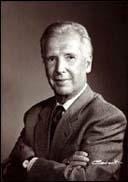Arthur Erickson, the internationally acclaimed Canadian architect known for his unflinching modernism, has died “in peace of old age” in a Vancouver hospital at age 84, according to family. Hailed as a powerful and poetic figure within the modernist movement, his works do not share a particular trademark aesthetic, but are otherwise notable for their horizontal lines and use of concrete, which he considered his “muse,” thanks to its versatility and ability to take on the aspects of other building materials.
Erickson rose to prominence in the mid-’60s thanks to his award-winning, monumental mountaintop commission for Burnaby’s Simon Fraser University campus — an Acropolis-like design which won the selection process despite contravening several of the project guidelines. Although fiercely protective of his private life, Erickson nonetheless revelled in his new-found fame, jet-setting around the world with his long-time companion and interior design partner Francisco Kripacz. Invitations to their bijou Point Grey home were a hot commodity in those heady days, according to friend Gordon Smith, who, in a 2006 profile of the architect in Vancouver Magazine, recalled indulgences such as fireflies being trucked in from the Praries to light up his beloved garden or a hot tub overflowing with dancers from the Royal Winnipeg Ballet. “They were very extravagant,” Smith said of Erickson and Kripacz (who died of respiratory failure in 2000). “And it enriched his art, you know.”
From his stiff, almost brutalistic beginnings (the concrete waffle of Vancouver’s MacMillan Bloedel Building), he would eventually incorporate both the landscape and the history of a particular site in to his work (as he did when he mirrored the post-and-beam construction techniques of the Pacific First Nations in concrete at UBC’s Museum of Anthropology), or weave intricate symbolism into massive civic projects. “He re-introduced a spiritual dimension to architecture,” says architectural historian, curator and author of Arthur Erickson: Critical Works, Nicholas Olsberg of Erickson’s landmark Robson Square development. “Before the NDP came to power in 1972, the Social Credit government was going to build a huge tower. Arthur came in and said ‘This won’t be a corporate monument. Let’s turn it on its side and let people walk all over it.’ And he anchored it in such a way with the courts — the law — at one end and the museum — the arts — at the other. The foundations of society. And underneath it all, the government offices quietly supporting their people. It’s an almost a spiritual progression.”
However, according to Olsberg, Erickson’s designs weren’t always so reverential. The Canadian Embassy in Washington, DC (for which Erickson was hand-picked by his good friend, then prime minister Pierre Trudeau), is a study in protest architecture. “It’s making fun of the ridiculous terms to which buildings must adhere in Washington,” says Olsberg, who points out the District’s zoning-mandated columns on the embassy’s facade, which are hollow and don’t support any of the building’s weight, as a sign of the architect’s artistic rebellion. “He was mocking the US and all of its imperial pretensions, and [he] was determined to get his message across,” says Olsberg.
“He was brilliant as long as you accepted his parameters,” says Gordon Price, an urban planner and director of the City Program at Simon Fraser University, who can recall a particularly tone-deaf submission by Erickson for the development of Coal Harbour in the late 1980s. “He had this plan for a great, sweeping parkway along the waterfront at a time when, politically, no one, be it NPA or COPE, was going to put a highway next to the waterfront. Not in Vancouver.” Despite a penchant for the monumental over the municipal, Price notes that Erickson’s extreme affinity for the natural beauty of the West Coast always came through in his work. “He was so deeply rooted in landscape, in his relationship to the landscape, he just had a very different conception of how a city should work because of his modernist roots,” he says, adding: “If you look at Robson Square, you can see he’s brilliant when it comes to stairs, and cantilevers, and mirroring nature. He had a skill with his grandiose vision, a harmony that few could match.”

 Why you can trust Xtra
Why you can trust Xtra


